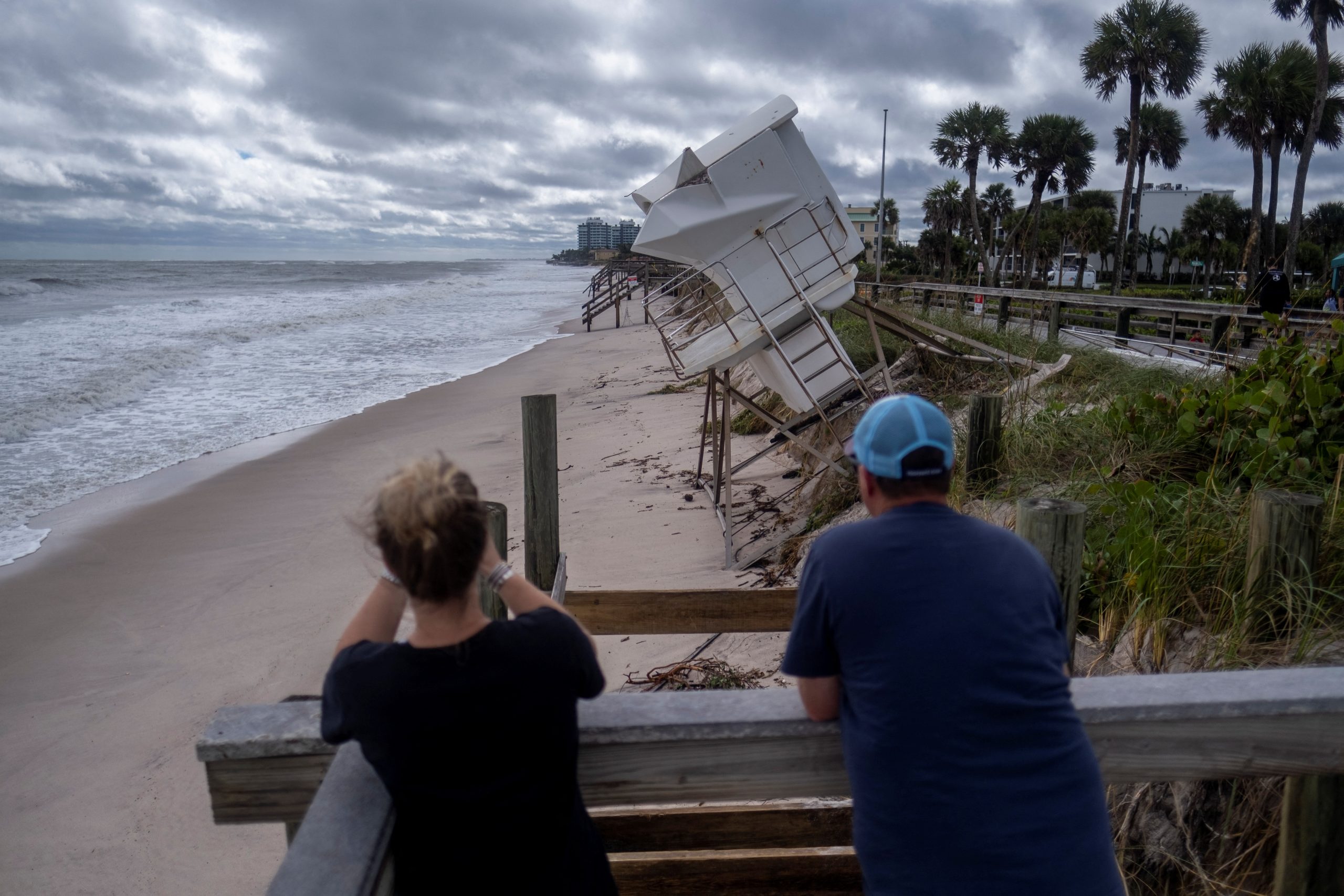
[elfsight_social_share_buttons id=”1″]
Tropical Storm Nicole swept across Florida on Thursday, weakening but still carrying a powerful punch with a mix of heavy rains and fierce winds that downed power lines, flooded homes, and left at least two people dead.
As many as 350,000 homes and businesses across Florida were without power on Thursday after the storm struck the Atlantic Coast near Vero Beach, north of Miami, at 3 a.m. EST, as a late-season hurricane packing sustained winds of 75 miles per hour.
The year’s eighth Atlantic hurricane and its 14th named cyclone system, Nicole was downgraded to a tropical storm soon after moving inland and later to a depression, though it still caused extensive damage to many houses along the coastline.
Nicole was expected to become a post-tropical cyclone on Friday and was continuing to bring heavy rains to the southeast, the National Hurricane Center said late on Thursday.
“We’re ready and resources are available for the post-storm needs,” Florida Governor Ron DeSantis said at a press conference. “This is still a large storm and it is impacting much of the state.”
Several beachfront homes collapsed in the upscale community of Wilbur-by-the-Sea, just south of Daytona Beach, and several more were left teetering on the brink after surging waves of surf kicked up by high winds undercut the buildings’ foundations.
Drone video shows a string of homes left in ruins in Daytona Beach Shores after Nicole tore through Florida. Watch the full video here:https://t.co/7F3JiyJGO1 pic.twitter.com/aj8PiYjj2i
— News 6 WKMG (@news6wkmg) November 11, 2022
The homes had already been vacated and no one was injured, Volusia County Sheriff Mike Chitwood said.
About 150 residents from two shoreside condominium complexes had been evacuated on Wednesday because the buildings were in danger of collapse from crumbling seawalls, Chitwood said.
In Vero Beach, the Indian River County seat closer to where the storm’s center made landfall, much of the town’s boardwalk was washed out by pounding waves cresting 25-30 feet high.
Volusia and Indian River counties were among several east coast areas hard hit six weeks ago by Hurricane Ian, a catastrophic Category 4 storm that initially struck Florida’s Gulf Coast, then swept across the state to the Atlantic, causing some $60 billion in damage and killing more than 140 people.
Kevin Guthrie, Florida’s emergency management director, cautioned residents on Thursday to remain indoors, even if the eye of Nicole had passed.
“There are heavy winds and a potential for tornadoes,” he said.
Moon rocket rides out storm
Wind gusts clocked at 100 mph at the Kennedy Space Center in Cape Canaveral, about 80 miles north of Vero Beach, buffeted a new $4 billion moon rocket that NASA left moored to its launchpad to ride out the storm. But NASA said early inspections showed the spacecraft sustained only minor damage such as loosened caulk and torn weather coverings.
Our @NASAGroundSys team regained access to the pad last night after the storm passed to survey @NASA_SLS & @NASA_Orion. Our employees are our top priority as Florida recovers. Today, we'll conduct a power-on test, make minor repairs, & continue preparing for #Artemis I's launch. pic.twitter.com/efHscY8D7Z
— Jim Free (@JimFree) November 11, 2022
By evening, Nicole had veered to the northwest as it churned over central and northern Florida toward the panhandle on the Gulf Coast, with maximum sustained winds clocked at 40 mph, mainly over the Gulf of Mexico, the National Hurricane Center reported.
Showers and blustery winds from the storm extended as far away as Atlanta, Georgia’s largest city in the state’s northern tier, by afternoon.
Most of Florida’s 22 million residents remained under various storm warnings and watches. Video showed whitecapping waves barreling ashore and crashing over beaches as winds whipped electrical lines and the tops of palm trees.
Check out these scenes from Thursday as #Nicole battered the Florida coastline! #FLwx pic.twitter.com/Bh4phiDs54
— WeatherNation (@WeatherNation) November 11, 2022
Officials said two people died on Thursday after coming into contact with a wind-downed power line. About 17,000 utility workers were staged across the state to restore electricity once the storm was over.
State officials opened 15 emergency shelters across the region and activated 600 National Guard troops.
More than 60 school districts across the state were shuttered on Thursday. Orlando International Airport ceased commercial flights on Wednesday while Walt Disney parks and other theme parks were temporarily closed.
Before reaching Florida, Nicole unleashed extensive flooding across much of the Bahamas, including the islands of Grand Bahama, Eleuthera, Andros and the Abacos.
The storm was declared a hurricane on Wednesday evening as it made its first landfall on Grand Bahama island in the northwestern corner of the Atlantic West Indies archipelago nation.
Nicole is only the second hurricane on record to make landfall in the continental United States after Nov. 4. Hurricane Kate came ashore near Mexico Beach, Florida, on Nov. 21, 1985, said Philip Klotzbach, a hurricane expert at Colorado State, on Twitter.
The Atlantic hurricane season officially runs from June 1 to Nov. 30.
Copyright 2022 Thomson/Reuters
